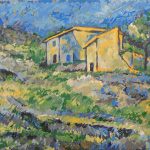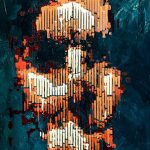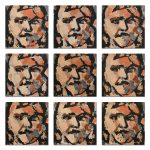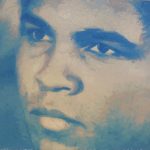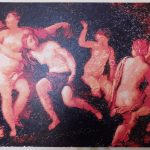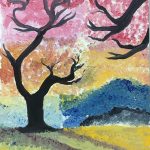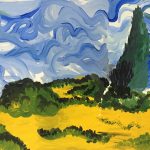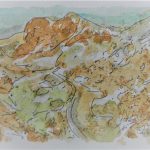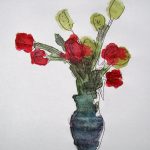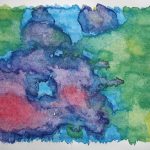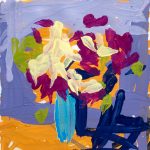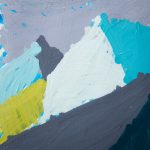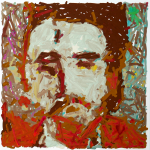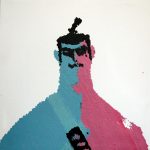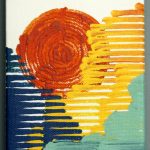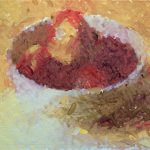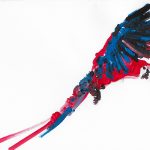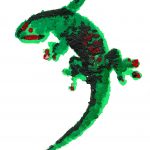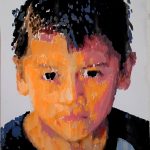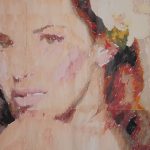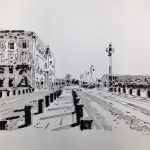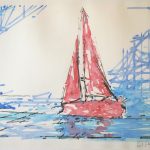In 2018, we had 19 teams from all over the world submit over 100 robot-created artworks. Winners were determined based on a combination of public voting (over 2000 people with a Facebook account), judges consisting of working artists, critics, and technologists, and by how well the team met the spirit of the competition – that is, to create something beautiful using a physical brush and robotics and to share what they learned with others. Learn more about the goals of the contest and its rules here. See the previous winners: 2017, 2016.
Read more about robot art (useful for journalists/press).
… and now, for the team winners of the 2018 Robot Art Competition…
1st Place – $40,000 CloudPainter – Independent (USA)
Incorporating machine-learning technology, CloudPainter was able to paint evocative portraits with varying degrees of abstraction. The source code and 3d models for CloudPainter are available online, and its creator has written about and given talks on his philosophy and methodology.
2nd Place – $25,000 – PIX18 / Creative Machines Lab – Columbia Univeristy (USA)
The Columbia team, coming off of their 2017 win, continued with a collection of impressionistic artwork showing a high level of skill with brushstrokes.
3rd Place – $10,000 – CMIT ReART – Kasetsart University (Thailand)
Artists program this robot brushstroke by stroke, using a haptic recording system that generates volumes of data about the position of the brush and the forces being exerted. When re-played, reART will generate a perfect reproduction of the original strokes. Haptic recording and playback allows for remarkably high-quality ink brush drawings.
4th Place $6000 – Late Night Projects – Independent
Created by an electronic engineer that loves art and mechanical systems, this robot worked after hours when the kids (and wife) are in bed. The robot uses vision to help mix paint more accurately. The painting were done in 3 steps. 1) drawing an outline of major edges to provide structure to the painting. 2) painting the values (brightness/contract) of the image with a large brush in black/white. 3) adding color with a thin brush.
5th Place $5000 – Joanne Hastie – Independent (Canada)
Joanne is an artist based in Vancouver, BC, Canada who paints cityscapes and landscapes using acrylic paint on canvas and paper. This background helped her create paintings of interesting composition and layering.
6th Place $2000 – Jeremy Kraybill – Independent (Australia)
Jeremy been working on computer-generated and AI-based creative projects for several years and interested in technology as a tool for human expression. While only submitting one painting, it showed promise.
7th Place $2000 – BABOT – Massachussetts Institute of Technology (USA)
Each team member has different favorite painting mediums and varying approaches to painting. We’ve focused on developing creating art that’s embracing to watch and entertaining to develop. This resulted in an eclectic assortment of paintings.
8th Place $2000 – Ozpainter (Australia)
Ozpainter was builted by an artist from Australia, working mainly in oils and acrylics on canvas or art boards. His goal for this competition was to create a robotic system that could produce artwork that that was not distinguishable from artwork done by a human artist.
9th Place $2000 – CARP Worcester Polytechnic Institute (USA)
The project was started by a group of seniors at WPI, building a painting robot for our engineering capstone.
10th Place $2000 – Portrait Painter Robot Project – Independent (Spain)
While perhaps not the most creative robot name, the Portrait Painter Robot robot paints portraits using a digital image as a source of information. Completely autonomous, with automatic mixing color system, the robot can generate up to 150 different colors.
Honorable Mentions $1000/each
A Roboto – Data Science Lab (Japan)
Busker Robot -University of Udine (Italy)
HHS Drone Painting – Hesperia High School (USA)
RoboLions – University of Sydney (Australia)
